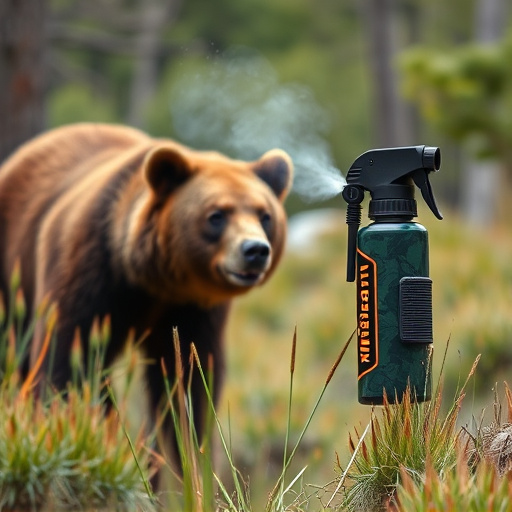Bear spray, a popular safety tool for hikers in bear country, uses capsaicin from chili peppers to deter bears. While effective, prolonged environmental exposure can cause ecological damage due to synthetic chemicals persisting in soil, water bodies, and vegetation. Responsible usage, disposal, and choosing eco-friendly options are crucial to balance personal safety with preservation of the natural landscape for both hikers and wildlife, mitigating the Environmental Effects of Bear Spray Decomposition.
“GrizGuard bear spray has emerged as a vital tool for hikers navigating high-risk areas, offering a powerful defense against potential bear encounters. This article delves into the intricacies of bear spray, examining its composition and effectiveness in deterring bears. We also explore the surprising environmental impact of bear spray decomposition, highlighting the need for responsible usage. By understanding the best practices for employing this safety measure, hikers can ensure their time outdoors is both enjoyable and secure, while also minimizing the ecological footprint.”
- Understanding Bear Spray: Composition and Effectiveness
- Environmental Impact of Bear Spray Decomposition
- Best Practices for Using Bear Spray Responsibly in the Wild
Understanding Bear Spray: Composition and Effectiveness
Bear spray, also known as urushiol-based repellent, is a crucial tool for hikers navigating areas with bear populations. Understanding its composition and effectiveness is essential for hiking safety. The primary active ingredient in bear spray is capsaicin, derived from chili peppers. This chemical irritates bears’ eyes, nose, and respiratory system, creating a temporary disorientation that allows hikers to escape potential threats.
Beyond its immediate impact on bears, the environmental effects of bear spray decomposition are worth considering. While non-toxic to plants and wildlife in small doses, prolonged exposure or accumulation can have ecological consequences. Proper usage, including avoiding spray misting water sources or dense vegetation, minimizes these impacts. Additionally, choosing environmentally friendly options and proper disposal methods contribute to preserving the natural landscape for future generations of hikers and wildlife alike.
Environmental Impact of Bear Spray Decomposition
Bear spray, a popular self-defense tool for hikers and outdoor enthusiasts, has a significant environmental impact once it enters ecosystems. The decomposition process of bear spray in natural environments raises concerns about its effects on soil, water bodies, and wildlife. Unlike organic matter that undergoes natural biodegradation, bear spray contains synthetic chemicals that may persist in the environment for extended periods.
The Environmental Effects of Bear Spray Decomposition are multifaceted. When sprayed onto vegetation or absorbed into the soil, these chemicals can disrupt plant growth and contaminate groundwater. Additionally, runoff from treated areas during rainfall or snowmelt can introduce these substances into nearby rivers, lakes, and streams, potentially harming aquatic life. Understanding these environmental implications is crucial for responsible bear spray usage and disposal to minimize ecological damage.
Best Practices for Using Bear Spray Responsibly in the Wild
When using bear spray responsibly in the wild, it’s crucial to understand best practices that balance safety with minimizing environmental impact. Start by ensuring your spray is EPA-registered and contains a blend of capsaicin, a natural pepper compound, and other additives designed to deter bears. Always carry bear spray in an easily accessible yet secure location on your person or gear. Before encountering a bear, give it ample space and time to retreat; use bear spray only as a last resort. Aim for the bear’s face and eyes, moving from side to side to ensure full coverage. Follow up with loud, threatening noises to reinforce the deterrence.
Proper disposal of used bear spray is vital to consider. Unlike some consumer products, bear spray decomposition can have environmental effects. Look for disposals instructions on the product label, often involving flushing or burning (in safe, controlled conditions) to avoid contaminating water sources and soil. Remember that responsible use, combined with proper disposal, helps preserve the wilderness experience for future generations while minimizing potential harm to wildlife and ecosystems.
Bear spray is a valuable tool for hikers navigating wild environments, but understanding its environmental impact is crucial. The decomposition process of bear spray can have varying effects on the ecosystem, highlighting the need for responsible usage. By following best practices, such as using it only when necessary and disposing of empty cans properly, hikers can ensure they protect both themselves and the natural world. When used responsibly, bear spray can be a game-changer for safety in the wilderness, minimizing negative environmental impacts.
